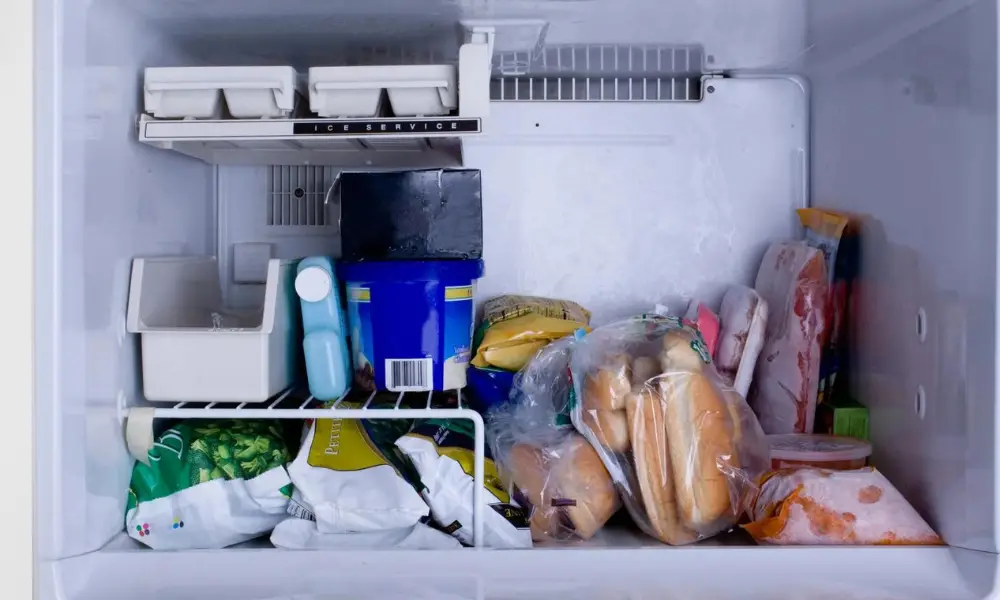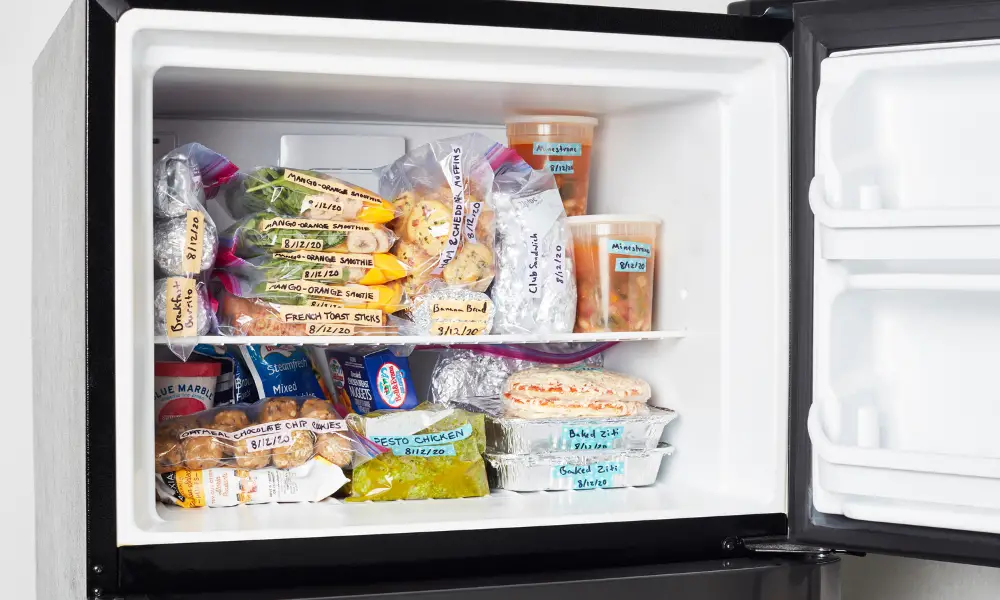Losing electricity can be a nightmare when you have a deep freezer full of food. This is where you keep your meat and other supplies so you have them for a while.
A power outage can be disastrous for food in your deep freezer that costs hundreds or even thousands of dollars. How much time do you have to get your freezer working properly before your food spoils?
Food can be frozen in a deep freezer for two to three days without power. Your freezer’s capacity determines how long all your frozen items will remain. Add dry ice to the freezer to keep food frozen, and only crack the lid when necessary.

How Long can a Deep Freezer go without Power?
If you have a big family, having a deep freezer is a terrific method to keep excess food. However, losing electricity can be a scary experience.
If the power outage lasts longer than 2-3 days, you may employ a few tactics to increase the time your food will stay frozen. Your food will typically stay frozen for 48–72 hours.
Because it might be dangerous to eat ruined meat, it is crucial to use a food thermometer to check the temperature of any food that may have defrosted.
If you lose power, take these extra precautions to ensure that your food remains frozen for as long as possible.
Most health and safety professionals concur that food can be kept at a safe temperature for up to 48 hours in a freezer. Below 40 degrees Fahrenheit is typically considered the “safe” temperature. Accordingly, a freezer will keep food frozen for 48 hours before it thaws and likely reaches a hazardous zone of 40 degrees or above.
What are the Five Factors that will Decide How Long the Freezer will go Properly?
Your Frequency of Freezer Opening
The most significant and controllable factor is how frequently the freezer is opened when the electricity is out. When there is no power, the cold air that escapes from an open freezer door cannot be replaced. This indicates that whenever the freezer door is opened, the temperature within the freezer rises, which accelerates the melting of frozen foods.
Perishables should be moved to a freezer with lots of ice at this time, and you should start cooking what you can. For the duration of the power outage, it is preferable to keep the freezer closed. You can check the freezer thermometer to ensure it is still at a safe temperature after 48 hours.
How Full is the Freezer
How long it can survive without power safely depends on how much food and other perishable items there are. For instance, there isn’t much to keep an empty freezer cool. This indicates that the temperature will rise more quickly once the restricted goods have thawed.
On the other hand, a fully stocked freezer with products like ice and dense meats may maintain its cold for much longer. To keep your freezer colder for longer, it is advisable to load it with water bottles and ice packs before a storm.
What’s in the Freezer
How long your refrigerator will stay cold depends on the contents you store inside. Rolls and other baked items tend to heat up rather quickly. On the other hand, products made of water and meat take a lot longer to heat up.
This is so because objects like ice require a lot of energy to heat up due to their high specific heat. The other reason people grab water bottles and ice before a storm is that frozen water significantly extends the time a freezer stays cold.
Insulation Quality and Outside Temperature
The quality (and age) of your freezer and the outside temperature are other considerations. No outside temperature; your freezer will probably stay cold for the best time if it is brand new and has airtight seals.
However, heat may slowly seep in if your freezer’s seals are slightly weak or imperfect. Here, the outside temperature may be a factor. For instance, a storm during the winter will probably cause your freezer to remain colder for a longer period than a tropical cyclone.
Freezer Size
The size of a fridge can affect how long a freezer keeps cold, just as a full freezer can maintain its temperature longer than an empty one. For instance, a large, fully-stocked deep freezer can keep food fresh for up to 4 days. A small freezer inside a refrigerator might only be functional for 24 hours. This is so that there is more frozen food in a larger freezer, meaning it will take more time to heat all that surface area. After all, ice cubes melt faster than icebergs.
How to Prepare your Deep Freezer for a Power Outage?
You can take measures to extend the time your freezer will stay frozen if you anticipate a power outage or want to be ready in case one occurs in the future.
First, make sure to maintain your freezer periodically. To keep any frost from accumulating and to ensure that the freezer is tightly shut, you should clean your gaskets and vents.
Filling space in your freezer is the first thing to do if there is any.
It is possible to fill empty bottles with water. In the event of a power outage, this will aid in keeping the freezer as cold as possible. Large water/soda bottles or frozen milk jugs work well for this.
The temperature inside will stay cooler for longer if you can freeze them before the power loss. Additionally, it provides clean water while you wait for the electricity to be restored.
Additionally, you’ll want to confirm that your freezer is set to 0°F (-18°C) or lower. You can extend the food’s time before it spoils by making the freezer colder before the power goes out.
Make sure your meat is cooked through. You should ensure your meat is at the bottom of the freezer. These items on the bottom will also stay cold longer, which is critical to saving your meat.
What to Eat First During a Power Outage from the Deep Freezer?
Eat the most easily spoilt foods, such as ice cream and frozen meals.
Remember to replace anything you take out with ice or bottles of cold water. To make your vegetables live longer, remove them and dehydrate them.
The most crucial thing to remember is never to open your freezer unless you absolutely must.
It will lose part of the chilly air and get some warm air each time you open it.
Using a flashlight and crawling under a large blanket over the freezer is a good idea to get things out. The cold air will be kept inside thanks to this.
What is the Best Way to Check if your Frozen Food is Safe to Eat?
You must check the freezer as soon as the electricity is restored. You can tell whether or not the contents—and which contents—are safe to consume by looking for several signals.
Thermometer Check
You need to check the freezer’s thermometer as soon as the power is restored. After all, once power is restored, you may anticipate a sharp drop in the temperature. The largest piece of meat in the freezer can be chosen, and its temperature can be checked using a meat thermometer if you forget to do this for a short while.
You should feel assured when the temperature is below 40 degrees or frozen. Eating is probably not safe if the temperature is close to 40 degrees. When in doubt, toss it out, as the phrase goes.
Still Frozen Food
The likelihood is that all perishable food items in the freezer are still safe if the food and water you kept inside are frozen. On the other hand, you should exercise caution if you see that everything has thawed.
Remove the more delicate food items from the freezer. Meats, poultry, and dairy products are included in this. Various other things should be secure, including baked foods and frozen veggies. But only if the temperature d be at or above 40 degrees Fahrenheit.
Ice Crystals or Water Puddles
Regularly defrosting your deep freezer is a good idea because ice buildup can be a real hassle. However, this frost might come in handy when figuring out whether or not your freezer kept your food safe.
A sign that your freezer maintained a below-freezing temperature for the majority of the time is the presence of those annoying ice crystals or even a thin coating of ice along the edge.
However, this is a danger indicator if you see a pool of water at the bottom of your refrigerator or a fresh sheet of ice (which was probably a pool of water before the freezer came back on).
This does not necessarily imply that the temperature of your deep freezer was above 40 degrees, which is dangerous. However, it implies that it was above 32 degrees long enough to cause significant ice to melt.
Reference: Guidelines for Food Safety During Short-Term Power Outages Consumer Fact Sheet
Every Californian occasionally experiences a random, unforeseen power outage. Blackouts are the usual name for these power interruptions. A blackout raises safety concerns about some foods. Perishable foods that are moist require specific treatment. When these foods are kept in the danger zone (40° to 140°F, or 4° to 60°C), bacteria can proliferate swiftly. Food safely stored at the start of the power loss is not harmed by power outages lasting two hours or less. Consult publications that deal with extended power disruptions for blackouts lasting more than two hours.
Conclusion
How long a freezer can keep food cold depends on several variables, including its size, contents, and frequency of opening. Without power, food in a deep freezer lasts around 48 hours. When mostly empty, a freezer may only be able to keep food frozen for up to 24 hours. However, if your deep upright freezer is completely loaded, it might keep your food cool and secure for up to four days.
Your safety depends on knowing how long your freezer can operate without electricity. Knowing how long perishable food can last will be helpful in the event of a weather calamity. It will also evaluate whether the food in issue is suitable for consumption once the power is restored. You should not take a chance at food poisoning. Therefore, your safety must understand the factors at play when keeping a freezer cold without power.

